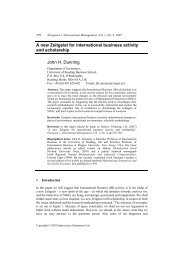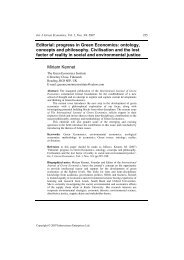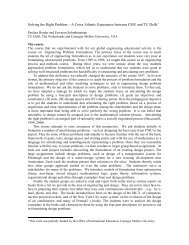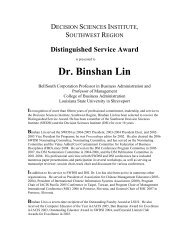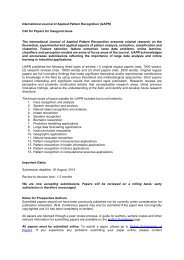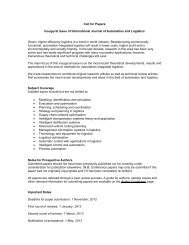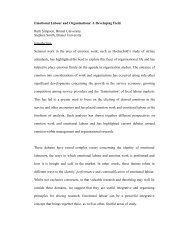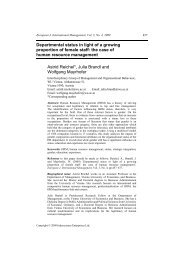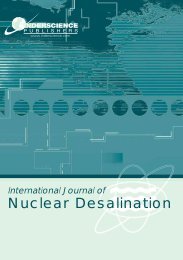Theories of the Firm
Theories of the Firm
Theories of the Firm
You also want an ePaper? Increase the reach of your titles
YUMPU automatically turns print PDFs into web optimized ePapers that Google loves.
acquire <strong>the</strong>m through joint ventures and alliances. The weakness <strong>of</strong> this <strong>the</strong>ory is that it<br />
does not take into consideration agency costs or firm evolution, nei<strong>the</strong>r does it explain<br />
how vertical integration should take place in <strong>the</strong> face <strong>of</strong> investments in human assets,<br />
with unobservable value, that cannot be transferred.<br />
The Principal–Agent Theory <strong>of</strong> <strong>the</strong> <strong>Firm</strong> extends <strong>the</strong> neoclassical <strong>the</strong>ory by adding<br />
agents to <strong>the</strong> firm. The <strong>the</strong>ory is concerned with friction due to asymmetric information<br />
between owners <strong>of</strong> firms and <strong>the</strong>ir stakeholders or managers and employees; <strong>the</strong><br />
friction between agent and principal, requires precise measurement <strong>of</strong> agent<br />
performance and <strong>the</strong> engineering <strong>of</strong> incentive mechanisms. The weaknesses <strong>of</strong> <strong>the</strong><br />
<strong>the</strong>ory are many: it is difficult to engineer incentive mechanisms, it relies on complicated<br />
incomplete contracts (borderline unenforceable), it ignores transaction costs (both<br />
external and internal), and it does not allow for firm evolution.<br />
The Evolutionary Theory <strong>of</strong> <strong>the</strong> <strong>Firm</strong> places emphasis on production capabilities and<br />
process as well as product innovation. The firm, according to this <strong>the</strong>ory, possesses<br />
unique resources, tied semi-permanently to <strong>the</strong> firm, and capabilities; <strong>the</strong> firm’s<br />
resources can be classified into four categories: financial, physical, human and<br />
organisational. The <strong>the</strong>ory sees <strong>the</strong> firm as a reactor to change and a creator <strong>of</strong> change<br />
for competitive advantage. The firm, as a creator <strong>of</strong> change, may cause creative<br />
destruction, which in turn may give birth to new industries and enable sectors <strong>of</strong>, or<br />
entire, economies to grow. Although many countries have established architectures to<br />
support entrepreneurial endeavours, a weakness <strong>of</strong> <strong>the</strong> <strong>the</strong>ory remains: process and<br />
product innovation (especially <strong>the</strong> latter) are mostly due to serendipity and as a result<br />
‘entrepreneurship’ is a very expensive factor <strong>of</strong> production; in <strong>the</strong> pursuit <strong>of</strong> pr<strong>of</strong>it and<br />
general wellbeing, it cannot be easily programmed within a firm or a nation.<br />
The book consists <strong>of</strong> nine chapters followed by an epilogue:<br />
• Chapters 1 and 2 describe <strong>the</strong> external environment <strong>of</strong> <strong>the</strong> firm and <strong>the</strong> firm’s<br />
decision-making process with emphasis on strengths and weaknesses <strong>of</strong> <strong>the</strong><br />
following models: rational, satisficing, probabilistic (inclusive <strong>of</strong> Bayesian) and<br />
behavioural.<br />
• Chapters 3–6 are devoted to <strong>the</strong> Neoclassical Theory <strong>of</strong> <strong>the</strong> <strong>Firm</strong> and some <strong>of</strong> its<br />
applications, ranging from market structures to managing a portfolio <strong>of</strong> risky<br />
assets and from free pricing to regulation.<br />
• Chapter 7 describes <strong>the</strong> Transactions Cost Theory <strong>of</strong> <strong>the</strong> <strong>Firm</strong> and its variants as<br />
well as hybrids (structures between <strong>the</strong> extremes <strong>of</strong> markets and hierarchies).<br />
• Chapter 8 focuses on <strong>the</strong> Principal–Agent Theory <strong>of</strong> <strong>the</strong> <strong>Firm</strong>, <strong>the</strong> central problem<br />
<strong>of</strong> which is how to induce <strong>the</strong> agent to act in <strong>the</strong> best interests <strong>of</strong> <strong>the</strong> principal<br />
when <strong>the</strong> agent has an informational advantage over, and different interests from,<br />
<strong>the</strong> principal.<br />
• Chapter 9 deals with <strong>the</strong> Evolutionary Theory <strong>of</strong> <strong>the</strong> <strong>Firm</strong>, built around <strong>the</strong><br />
concepts <strong>of</strong> creative destruction, competitive advantage, entrepreneurial styles<br />
and habitat, strategy and firm structure as well as entrepreneurial architecture.<br />
visit<br />
www.inderscience.com




